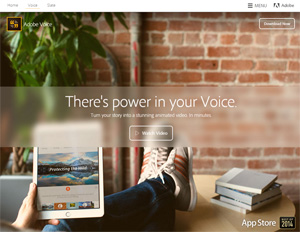
It’s easy for teachers to become overwhelmed by and get caught up in the latest new technology gadget. In spite of all the new technologies that appear almost daily, it is important to remember that “our focus must remain on the act of reading,” as Frank Serafini stated in
Reading Workshop 2.0. As a university faculty member, I am always looking for ways to model meaningful technology integration for my undergraduate and graduate students so that the focus remains on literacy instruction and not on the technology itself. I want to provide experiences for my students to take and use in their (future) classrooms to enhance and transform literacy learning.
Adobe Voice is a free app available for the iPad. It allows users to record their “stories” in their own voice with a touch of a button. In addition to being able to narrate their stories, users can add images, icons, and text, as well as select music that is already integrated into the app to create beautiful visual presentations of their content.
One of the most appealing features of Adobe Voice is its ease of use. Once the app is opened, Adobe provides several templates for content creation. Using the templates, users can write stories, teach a lesson, explain a concept, or promote an idea. Once a template is selected, Adobe then provides prompts to help the user create their content. Users may also opt not to use a template and make up their own. This feature is great to promote differentiated instruction. The app also offers multiple content layouts and options to add multiple images or icons, as well as text. A tutorial is available online.
I recently introduced Adobe Voice to my undergraduate Literacy Foundations students. Their assignment was to use the app to create a reflection on their recent field experience at a local elementary school. Only one student was familiar with the technology prior to our session, but within one class period they were all successful users. I asked my students to write a brief reaction after using Adobe Voice and they said overwhelmingly they liked using it and found it very easy to navigate.
Both Jillian and Maggie said Adobe Voice could be used successfully as assistive technology for students with special needs. Jillian also saw the benefit of this app as an assessment tool and a means to communicate with families. Lyndsey said she would have loved to have had this technology available when she was in school because she didn’t like to talk in front of people, and this would have given her another option for communicating in her classes. The majority of my students stated they would use Adobe Voice in their future classrooms. In just one class period, my students realized the value and versatility of this technology tool.
The possibilities for using Adobe Voice in the classroom are endless. The youngest learners who have not yet developed writing skills can use this technology to tell their stories. Students of all ages can show their learning in the content areas of math, science, and social studies, and it can serve as a tool for reader response. Teachers can use this as a tool for creating flipped classrooms and providing individualized instruction for their students. Adobe Voice is an extremely versatile tool that can be integrated easily into classroom instruction to transform literacy learning.
How will you use your Voice?
 Kristin Webber is an assistant professor in the Early Childhood and Reading Department at Edinboro University of Pennsylvania where she also serves as program head for the masters in education reading program. Her latest article “From Reluctant to Engaged” appears in the May 2015 issue of Educational Leadership.
Kristin Webber is an assistant professor in the Early Childhood and Reading Department at Edinboro University of Pennsylvania where she also serves as program head for the masters in education reading program. Her latest article “From Reluctant to Engaged” appears in the May 2015 issue of Educational Leadership.